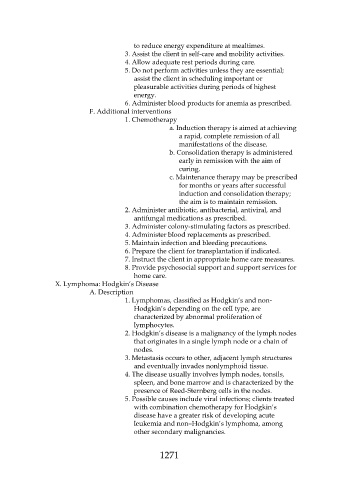Page 1271 - Saunders Comprehensive Review For NCLEX-RN
P. 1271
to reduce energy expenditure at mealtimes.
3. Assist the client in self-care and mobility activities.
4. Allow adequate rest periods during care.
5. Do not perform activities unless they are essential;
assist the client in scheduling important or
pleasurable activities during periods of highest
energy.
6. Administer blood products for anemia as prescribed.
F. Additional interventions
1. Chemotherapy
a. Induction therapy is aimed at achieving
a rapid, complete remission of all
manifestations of the disease.
b. Consolidation therapy is administered
early in remission with the aim of
curing.
c. Maintenance therapy may be prescribed
for months or years after successful
induction and consolidation therapy;
the aim is to maintain remission.
2. Administer antibiotic, antibacterial, antiviral, and
antifungal medications as prescribed.
3. Administer colony-stimulating factors as prescribed.
4. Administer blood replacements as prescribed.
5. Maintain infection and bleeding precautions.
6. Prepare the client for transplantation if indicated.
7. Instruct the client in appropriate home care measures.
8. Provide psychosocial support and support services for
home care.
X. Lymphoma: Hodgkin’s Disease
A. Description
1. Lymphomas, classified as Hodgkin’s and non-
Hodgkin’s depending on the cell type, are
characterized by abnormal proliferation of
lymphocytes.
2. Hodgkin’s disease is a malignancy of the lymph nodes
that originates in a single lymph node or a chain of
nodes.
3. Metastasis occurs to other, adjacent lymph structures
and eventually invades nonlymphoid tissue.
4. The disease usually involves lymph nodes, tonsils,
spleen, and bone marrow and is characterized by the
presence of Reed-Sternberg cells in the nodes.
5. Possible causes include viral infections; clients treated
with combination chemotherapy for Hodgkin’s
disease have a greater risk of developing acute
leukemia and non–Hodgkin’s lymphoma, among
other secondary malignancies.
1271

